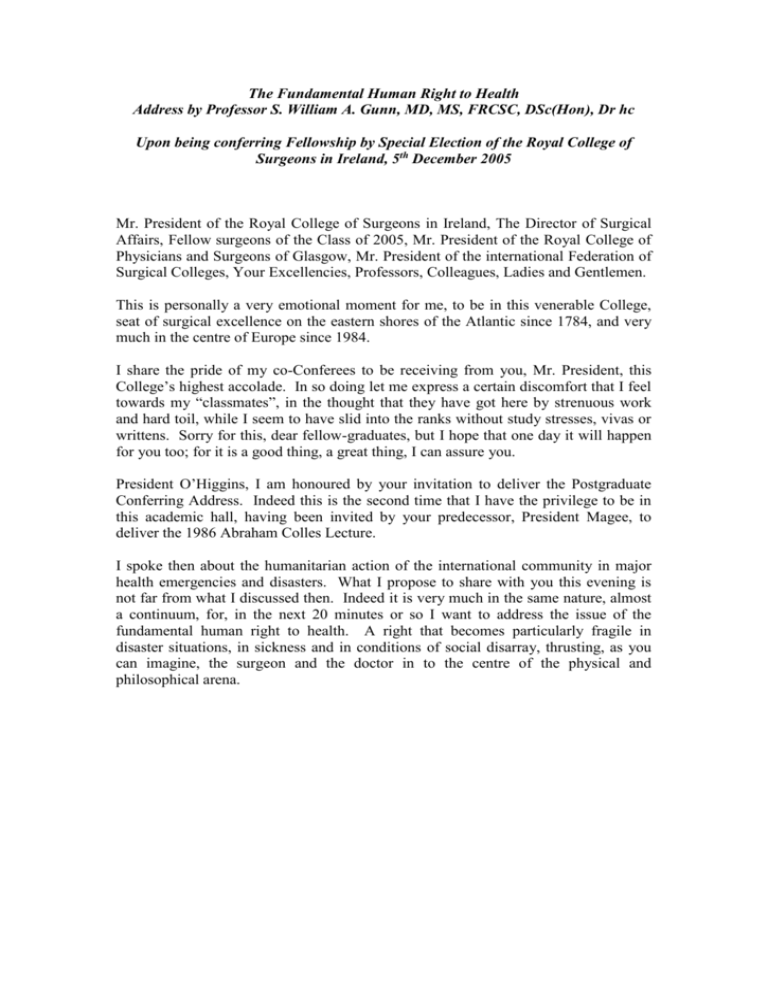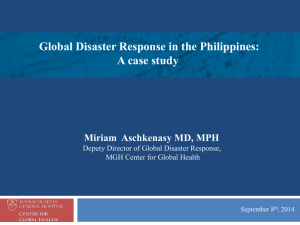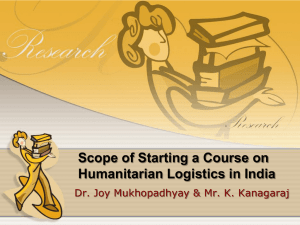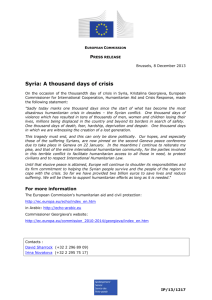The Fundamental Human Right to Health
advertisement

The Fundamental Human Right to Health Address by Professor S. William A. Gunn, MD, MS, FRCSC, DSc(Hon), Dr hc Upon being conferring Fellowship by Special Election of the Royal College of Surgeons in Ireland, 5th December 2005 Mr. President of the Royal College of Surgeons in Ireland, The Director of Surgical Affairs, Fellow surgeons of the Class of 2005, Mr. President of the Royal College of Physicians and Surgeons of Glasgow, Mr. President of the international Federation of Surgical Colleges, Your Excellencies, Professors, Colleagues, Ladies and Gentlemen. This is personally a very emotional moment for me, to be in this venerable College, seat of surgical excellence on the eastern shores of the Atlantic since 1784, and very much in the centre of Europe since 1984. I share the pride of my co-Conferees to be receiving from you, Mr. President, this College’s highest accolade. In so doing let me express a certain discomfort that I feel towards my “classmates”, in the thought that they have got here by strenuous work and hard toil, while I seem to have slid into the ranks without study stresses, vivas or writtens. Sorry for this, dear fellow-graduates, but I hope that one day it will happen for you too; for it is a good thing, a great thing, I can assure you. President O’Higgins, I am honoured by your invitation to deliver the Postgraduate Conferring Address. Indeed this is the second time that I have the privilege to be in this academic hall, having been invited by your predecessor, President Magee, to deliver the 1986 Abraham Colles Lecture. I spoke then about the humanitarian action of the international community in major health emergencies and disasters. What I propose to share with you this evening is not far from what I discussed then. Indeed it is very much in the same nature, almost a continuum, for, in the next 20 minutes or so I want to address the issue of the fundamental human right to health. A right that becomes particularly fragile in disaster situations, in sickness and in conditions of social disarray, thrusting, as you can imagine, the surgeon and the doctor in to the centre of the physical and philosophical arena. The Fundamental Right to Human Health Until barely a few decades ago health had mostly been regarded as a personal matter, implying a reciprocal relationship between patient and physician, as codified by the Hippocratic Oath. Today, however, health is considered a human right, with not only medical but also complex philosophical, ethical, socio-economic, political and legal implications. Additionally, children, the handicapped, the wounded and disaster stricken have their particular fundamental rights, such that the problem of health becomes a concrete issue within international and humanitarian law. I am a surgeon. Moreover I am an international health worker with ties to the World Health Organisation, the European Centre for Disaster Medicine of the Council of Europe and the International Association for Humanitarian Medicine. I shall therefore approach my theme as a citizen, physician, disaster relief provider and international doctor. I shall address the issue of The Right to Health as a fundamental Human Right. I propose to construct my statement on five basic instruments: the Universal Declaration of Human Rights, the Constitution of WHO, the United Nations Declaration of the Rights of the Child, Red Cross Conventions and the mission statement of the international Association for Humanitarian Medicine Brock Chisholm. The establishment of the United Nations in 1945 was a momentous event not only in global geopolitics, but also in international health. The San Francisco Conference, where the UN Charter was signed, considered it wise that a universal health organisation be set up. The ensuing International Health Conference approved the establishment of a new body, which began life on 7 April 1948 under the name of World Health Organisation and under the directorship of Dr. Brock Chisholm. The basic principle behind the constitution of WHO was the then totally new – not to say controversial – concept of man’s right to health. The Instruments I Although, chronologically, the Universal Declaration of Human Rights was in fact signed after the ratification of the WHO constitution, I shall take it up first. Of the 30 articles that the Declaration contains, Art. 25 is particularly concerned with the right to health. It states: 1. Everyone has the right to a standard of living adequate for the health and wellbeing of himself and of his family, including food, clothing, housing and medical care and necessary services, and the right to security in the event of unemployment, sickness, disability, widowhood, old age or other lack of livelihood in circumstances beyond his control. It further establishes that: 2. Motherhood and childhood are entitled to special care and assistance. All children, whether born in or out of wedlock, shall enjoy the same social protection. II Eight months before this Declaration was signed, the WHO Constitution had already injected new dimensions of social thinking, let alone new concepts of health. Its preamble states that “the enjoyment of the highest attainable standard of health is one of the fundamental rights of every human being…” and that the governments are responsible for the health of their peoples. It further enounces the principle that health is a matter of international politics, since “the health of all peoples is fundamental to the attainment of peace and security…”. Article 1 clearly points out the objective of WHO. This “… shall be the attainment by all peoples of the highest possible level of health”. And boldly – indeed for its times iconoclastically – WHO defines health as 3. A state of complete physical, mental and social well-being and not merely the absence of disease or infirmity. One can easily grasp the vastness and depth of the interpretation and its implications on the provision of and access to health services everywhere. III Health rights begin early in life. The UN Declaration of the Rights of the Child, signed in November 1959, proclaims the following Principles: 4. The child shall enjoy the benefits of social security. He shall be entitled to grow and develop in health: to this end special care and protection shall be provided both to him and to his mother, including adequate pre-natal and postnatal care. The child shall have the right to adequate nutrition, housing, recreation and medical services. 5. The child who is physically, mentally or socially handicapped shall be given the special … care required. As in many other instruments, the child is also protected in the Universal Declaration on the Eradication of Hunger and Malnutrition. Endorsed in December 1974, it proclaims that “Every child has the inalienable right to be free from hunger and malnutrition”. The sunken eyes of staring children seen daily on our screens, and the constant breach of all the solemn declarations mentioned above, constitute a flagrant breach of human rights, a breach perpetrated not uncommonly by kleptocratic leaders who rob and starve the populations they are supposed to govern and protect. IV The International Red Cross has specific principles for the protection of health. 1. The Geneva Conventions of 12 August, 1949, clearly protect the health and integrity of civilian populations and non-combatants as of right, and 2. The Additional Protocols of 1977 ensure that, even in war and combat conditions, medical personnel are protected without discrimination, so that they can perform their duties to uphold health. V. The International Association for Humanitarian Medicine Brock Chisholm continues the spirit of the Dr. Brock Chisholm Memorial Trust, founded in 1984 to perpetuate the ideals, legacy and action of the first DirectorGeneral of WHO. On first thought, all medicine, it may be argued, is humanitarian, but here is my definition that should clarify the concept: “While all medical intervention to reduce a person’s sickness and suffering is in essence humanitarian, Humanitarian Medicine goes beyond the usual therapeutic act and promotes, provides, teaches, supports and delivers peoples’ health as a human right, in conformity with the ethics of Hippocratic teaching, the principles of the World Health Organisation, the Charter of the United Nations, the Universal Declaration of Human Rights, the Red Cross conventions and other covenants and practices that ensure the most humane and best possible level of care, without any discrimination or consideration of material gain”. Here then, are five primordial instruments that proclaim health as a human right, formally and inalienably. Naturally these rights must be guaranteed and provided in practice, and at present the universally accepted strategy to ensure health for all is through the national and international efforts in support of essential care available to all. Health for All “Health for All” is in fact the name of the long-term thrust pioneered by WHO and supported by all countries as a realisable social goal and human right. If health is a human right, and human rights are for all humans – as indeed they are – then health too must be for all. And that is just what the WHO strategy is about. In fact, in 1977, the World Health Assembly, drawing attention to the vast health inequalities that exist throughout the world and to the inequitable distribution of resources to deal with this human tragedy, decided that the main social target of WHO for the coming decades would be the attainment by all citizens of the world, a level of health that would permit them to lead a socially productive life. That is the pragmatic and at once humanitarian concept of “Health for All”. The fundamental principle on which the programme and the strategy is based is that a country shall develop its own health policies in the light of its own particular health problems, its social situation, political mechanisms and economic possibilities, within a structured programme of sustainable development. The Untied National and world leaders have espoused the cause, and countries actively promote it. There is no question, however, of creating a pseudo-nirvana where all disease will have been abolished. Yet several things are clearly attainable: preventable illness should and can be prevented; there should and can be early diagnosis, treatment and rehabilitation for treatable conditions; there should and can be better continuing management for non-treatable diseases; and increasing regard must be paid not only to the length of life, but also to the quality of life. The fundamental right of man demands this. In fact social conscience had led humanity farther and higher. As early as 1978 the World Health Organisation proclaimed that “the health of all peoples is fundamental to the attainment of peace and security”. Conversely, a later WHO Assembly declared that “Peace is the most significant factor for the attainment of Health for All”. Which brings us full circle. And what a beautiful circle: Health > Human Rights > Peace > Health > References Bernier, P., Fonrouge, JM., Gunn, S.W.A., Legal, diplomatic and geopolitical concepts that physicians on international humanitarian missions should know. Prehospital and Disaster Medicine, 14: S87, 1999. Butros-Chali, B., From peace-keeping to peace-building. Lecture by the Secretary General. UN document PR/SG/SM/1330, May 1992. Diamond, J. The Rise and Fall of the Third Chimpanzee. Vintage, London, 1992. Gunn, S.W.A. La médecine des catastrophes : une nouvelle discipline. Helvetica Chirurgica Act, 52 :11, 1985 The effects of nuclear disaster on health. In Further Aspects of Disaster Medicine, T. Otsuka, Y. Yamamoto and N. Ninomiya, eds. Herusu Publicaitons, Tokyo, 1993. Multilingual Dictionary of Disaster Medicine and International Relief. Academic Publishers, Dordrecht, London, 1990. Kluwer The right to health. Cemec Monographs No. 2, European Centre for Disaster Medicine, San Marino, 1969. On man-conceived disasters. J of Humanitarian Med., 1:7-8, 2001 The scientific basis of disaster management. Disaster Prevention and Management Journal, 1(3): 16-21, 1992 Il presupposto umanitairo nel soccorso dolle catastrofi a livello internazionale. Oplitai. Ital. J. Emers., 5: 7-11, 1993 A humanitarian non-combat role for the military. Prehospital and Disaster Medicine, 9 (2) Suppl: 46-48, 1994 The right to health through international cooperation. Medicine, 1:1-3, 2000 Journal of Humanitarian Disasters and Conflicts. In Encyclopaedia of Life Support Systems, UNESCO, Paris 2002 United Nations, Human Rights – A Compilation of International Instruments. Untied Nations, New York, 1988 World Health Organisation, Basic Documents, WHO, Geneva, 1999






